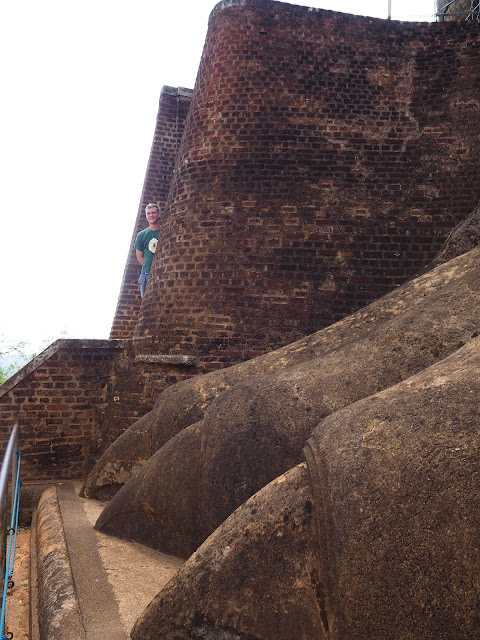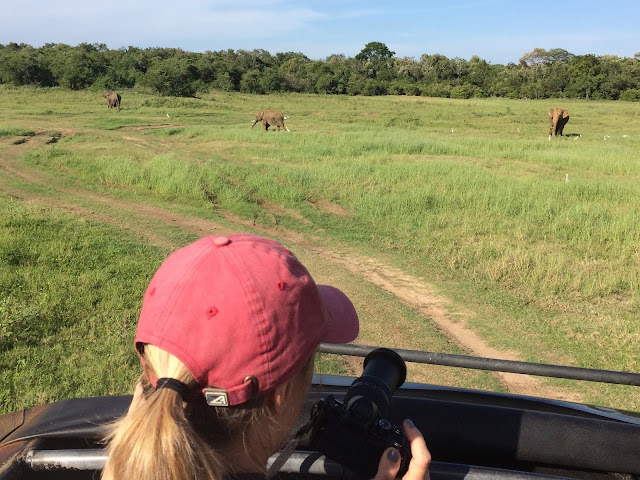Following a wonderful but hectic weekend enjoying the Singapore Grand Prix with our family and their friends, on Monday morning we all travelled to Changi Airport. From here BT and Michael flew off to Borneo, OS and NL to Bali and Papa T, HT and I caught the flight to Colombo for a week exploring Sri Lanka.
Being less than 4 hours flying time from Singapore we were soon in Colombo where we were met by Asoka who was to be our guide and driver. He presented us with pretty floral garlands which we all and particularly Papa T and HT felt rather embarrassed about wearing as we walked through the airport to the waiting car, but obviously we appreciated the kind gesture
A few hours driving later we arrived at our hotel in Habarana, where we would be based for the next few days. The Habarana Village by Cinnamon Hotel is close to a lake and there was plenty of animals and bird activity we could watch from our chairs. We politely declined to have an elephant ride but enjoyed seeing these amazing animals plod slowly through the grounds
It seemed like the local monkeys enjoyed relaxing on the sun loungers as much as the hotel guests
The poor pool man had quite a job stopping the monkeys stealing the beach towels whenever he turned his back
That evening there was a lovely sunset over Habarana lake
The next morning it was time to start exploring and our first stop was to Sigirya, a huge vertically sided rock rising up from the central plains. On the nearly flat top are the remains of an ancient fortress (or monastery depending on which theory is true)
On entering the World Heritage Site we walked through the remains of the water gardens
and lily and lotus flower covered ponds and moats
On some of the rocks you can see cuts in the rock that we were told had been carved into the rock centuries ago for the foundations for walls
Then we started climbing the first of what must have been hundreds of steps and staircases
Once through the boulder gardens we then started climbing the main rock, and up an open-air spiral staircase to see 5th century frescoes of women, thought possibly to be the concubines of King Kassapa. Photography isn't allowed of these precious paintings to help preserve them.
Further on and higher up we next came to 'Mirror Wall'
So called as it's smooth glazed sides contains images, dating back from the 6-14th centuries where visitors copied the frescoes below, ancient graffiti no less.
Asoka pointed out some Giant-honey bee hives above our heads us and suggested we keep quiet as the bees have previously attacked visitors if disturbed, a few visitors have reportedly died from being stung multiple times!
We thought he was being overly dramatic but a little further on we came to a large platform of rock where there were warning signs and a new first aid shelter was being build to tend to visitors who are stung
In this area a giant brick lion used to guard the final ascent to the top of the rock, with visitors having to pass between the paws and through the lion's mouth. Now only the paws remain but these give a good idea as to how huge the lion must have been
From here it was only a relatively short distance to the top but it was pretty tough climbing nearly vertically up. Now there are metal steps protruding from the rock, previously visitors would have ascended the narrow carved-out rock steps which looked perilous
We felt very pleased to make it to the summit and see the far reaching views
HT 'on top of the world' and thankfully not too close to the edge as it was a long way down!
On the terraced summit are the remains of what some believe is the fortified capital of King Kassapa (AD 477- 495) who fled here after murdering his father, King Dhatusena of Anuradhapura
the ancient fortress's water 'tank' still collects water
looking down we had a great view of the water gardens below
After we had explored the ruins, rested and enjoyed the fabulous views, we headed back down the seemingly endless steps
back on the ground Asoka showed us the King's audience hall
and a rock cave temple with altar and the remains of frescoes on the ceiling and walls
we walked under the aptly named 'Cobra Rock'
back to the palace gardens
which was full of hopeful monkeys looking for visitors who might feed them
We went back to our hotel to have some lunch and to rest before our afternoon safari
We set off for Kaudulla National Park and having got the necessary permits drove over a rather impressive dam with water control in/outlets
Although this park is relatively small (66sq km) it has a reputation, along with Minneriya National Park, for being a good place to see large numbers of elephants who towards the end of the dry season gather around the ancient reservoirs or 'tanks' as they are called in Sri Lanka.
Our first 'wildlife' sighting however was of a huge hornets nest with enormous hornets buzzing around-scary
Soon we came across a family of Toque Macaque monkeys which although endemic in Sri Lanka are on the list of endangered species worldwide
and another family group of the very beautiful Purple Faced Langur, also on the endangered list
Sri Lanka is world renowned for it's wildlife including it's birds, here's a White Throated Kingfisher
and a pair of Malabar Pied Hornbills
and as we drove out of the jungle onto the grassland we spotted several Red Wattled Lapwings

and then we came across our first elephant- a lone male
He didn't seem that pleased to see us, marched out from the bush and began to chase us! Our driver started to drive off but got stuck for a few moments on a log then thankfully managed to move off again just in time!
Further on we came to a small family group and watched them grazing peacefully
As the afternoon slowly turned to evening more and more elephants came out of the jungle and started making their way down to the 'tank' feeding off the rich grassland on their way
there were also lots of Indian Peafowl
small family groups of elephants started to combine and a large herd formed heading for the water
we were lucky to catch a quick glimpse of two Spotted Deer before they ran off
Close to the water we saw Pelicans, Brahminy Kites, Cormorants, Egrets and this Grey headed Sea eagle looking out for his supper
and a White Bellied Sea eagle
and several Lesser Adjutants, the largest bird in Sri Lanka
It was a real treat to sit quietly and watch the animals as they greeted each other, then fed on their way down to the reservoir

As we had to be out of the park before sunset we had to leave the herd and head back for our dinner.
We felt very lucky to have seen this amazing natural event; "The Gathering", and looked forward to visiting Minneriya National Park the following day and hopefully see yet more elephants





























































No comments:
Post a Comment